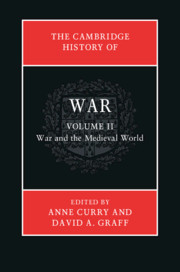Book contents
- The Cambridge History of War
- The Cambridge History of War
- Copyright page
- Contents
- Illustrations
- Maps
- Notes on contributors
- Introduction to volume II
- Part I Foundations, c.600–1000 ce
- Part II Interactions, c.1000–1300 ce
- Part III Nations and Formations, c.1300–1500 ce
- Part IV Comparisons: Cross-Cultural Analysis
- 22 Justifications, theories, and customs of war
- 23 Land technologies
- 24 Maritime technologies
- Select bibliography
- Index
23 - Land technologies
from Part IV - Comparisons: Cross-Cultural Analysis
Published online by Cambridge University Press: 25 September 2020
- The Cambridge History of War
- The Cambridge History of War
- Copyright page
- Contents
- Illustrations
- Maps
- Notes on contributors
- Introduction to volume II
- Part I Foundations, c.600–1000 ce
- Part II Interactions, c.1000–1300 ce
- Part III Nations and Formations, c.1300–1500 ce
- Part IV Comparisons: Cross-Cultural Analysis
- 22 Justifications, theories, and customs of war
- 23 Land technologies
- 24 Maritime technologies
- Select bibliography
- Index
Summary
The ages of humankind are designated by the material with which they made tools and weapons: stone, bronze, and iron. Remnants of these tools and weapons, found in archaeological excavations, are often the earliest evidence of existence in a place, especially before humans were able to express (and depict) themselves in words or art. Artistic depictions would follow, and then written ones, but both several thousands of years later. A wood, stone, or metal club, a stone or metal spearhead or arrowhead, a metal dagger or sword – and this appears to have been the progression – all could be used for hunting, likely their main function in pre-agricultural societies.
- Type
- Chapter
- Information
- The Cambridge History of War , pp. 640 - 661Publisher: Cambridge University PressPrint publication year: 2020
- 4
- Cited by

